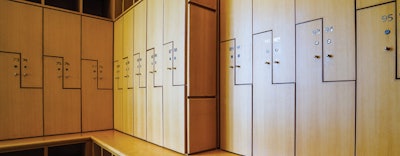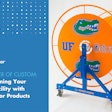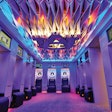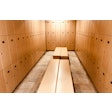
Common advice is to leave your valuables at home when you hit the gym. However, with keyless entry fobs now standard on most automobiles and $800 smartphones as seemingly necessary as tennis shoes, it's almost impossible to get a workout in without leaving something of value in a locker.
Fear not — lock technology has come a long way in recent years, with innovative solutions for ensuring peace of mind while also making management's job easier. Here's a look at some of the lock choices on the market, as well as factors to consider when deciding what's right for your facility:
Electronic combination
"The research that we did to identify what type of a technology solution made the most sense helped us realize that the technology is being used to help both the end-user and the facility manager," says Cris Smyczek, senior product manager at Master Lock.
RELATED: Purchasing Guide: What you need to know when buying lockers
Smyczek says electronic combination locks can help the end-user with things such as intuitive operation and clearly knowing which lockers are available, while easy-to-read displays that show battery life allow facility managers to spend less time on support in the locker rooms.
There's no use adopting technology for technology's sake, Smyczek admits. "But when it's a solid product and it performs well, it can really improve the interface for that end-user. And it can also streamline some of the cost efficiency and maintenance of the facility that the manager has to do."
Richard Shaffer, business development manager for Digilock, says that electronic locks can ease the pain of managing a large number of lockers. "When you've got a whole lot of lockers, management becomes cumbersome — you have members forgetting their code, more lockers to audit, more lockers to vacate," Shaffer says.
RELATED: Find more solutions for your facility in the Buyers Guide
Most high-end electronic units are complemented by a mobile app that allows for easier management of a large number of openings. "Our newer products allow you to do things like operate the management system with a mobile app, which goes on a dedicated device," Shaffer explains. "That allows users to add and remove management keys more easily, see when it's opened and closed, and there's also a battery meter."
That an electronic lock by definition requires a battery is an undeniable drawback to this option. Batteries are an extra expense and they can be a hassle, especially if you have more than 100 openings to manage. Tim Freeman, director at FJM Security Products, touts his company's breakthrough in battery life. "We have an electronic combination lock with 10-year battery life," Freeman says. "With most electronic locker locks, you'll have to change batteries about once a year. In that scenario, when you're dealing with 200 lockers, you don't do batteries one at a time — you have to set a timer and just switch out all the batteries at once. So, having a longer battery life, that's a great feature."
Mechanical
Mechanical locks definitely have their downside in that they're not as flexible as electronic locks. Most can't be set to single-use and then changed to accommodate multiple users, for example. They're also a little harder to maintain, since facility managers can't instantly audit them with an app or see which units are occupied at a glance.
That said, mechanical units essentially serve the same purpose as an electronic lock but at a much lower price point. "I would say if you look at our new mechanical models versus the electronic, we're talking a third of the price," says Freeman.
Another benefit of mechanical locks is their simplicity. Where there are fewer components, there's usually less that can go wrong. "Mechanical keys and combinations still have a place in certain environments because of budgets and simplicity," Smyczek says. "Some managers prefer them because there's no battery and they can be easier to troubleshoot because they've been around for so long."
Aside from ensuring your facility's lockers are secured with quality locks, you might also consider these simple best practices proven to deter thieves:• Issue scannable ID cards so you’re able to identify who was in the building should a theft occur. • Train staff to conduct random walkthroughs of locker rooms throughout the day. • Remind members to lock their valuables through posted signage and other communication, such as email newsletters. • Perform regular maintenance on your lockers to repair damage, as locker rooms in disrepair are a message to thieves that no one is monitoring the space. |
RFID
Radio-frequency identification (RFID) locks are perhaps the pinnacle of locker room lock tech at present. They can be accessed using a special card or in some instances the tap of a smartphone. They're also the most expensive option and may be just on the edge of technology for technology's sake.
Shaffer explains that RFID first caught on in Europe with adoption increasing recently in the United States. He notes that cost was typically the primary barrier to entry but adds that prices have come down considerably in recent years.
Smyczek cites the need for members to carry a card with them as one drawback to the option. "I think any time you go to the gym, anything you have to carry with you can be a bit of a burden," she says.
Locks of tomorrow
There are a number of high-tech possibilities on the horizon that are currently best suited for other applications, such as hotels or residential properties. Bluetooth- and smartphone-controlled locks are increasingly seen in smart-home setups but currently feature components that are simply too pricey for most locker room settings.
"Everybody is going to have a lock that operates with their cell phone. That is certainly technologically feasible," says Shaffer, adding that such technologies present unique challenges related to pairing and connectivity in the locker room. "How do you get a phone to pair with only one lock, when you've got dozens in very close proximity to it? That presents a technological challenge that we're trying to address. And then, how do you get it to pair and then unpair in a rapid-fire, easy way that the client doesn't have to pair their phone — like you pair your headsets — each and every time a new user comes in to use that locker?"
RELATED: PRODUCT SPOTLIGHT: Locker Room & Laundry Components
Biometrics — the use of a fingerprint or iris scan to gain access to a locker — might also become the norm someday. But there are regulatory and technological hurdles to these solutions. Smyczek cites the size and cost of components, as well as the need for exceptionally long battery life and robust processing power, as the primary reasons biometrics have not yet been adopted in the locker room. "We're still not at that tipping point where we've seen that cost-to-value proposition come out, but there's certainly room for it as people have gotten used to biometrics on their phones," she says. "It's obviously something we've been looking at, but how fingerprints are stored and how they're used, in our research, is a big deal to end-users. They're concerned about it, and what exacerbates that is that a lot of states are now proposing biometric legislation that stipulates how you can collect and use and store that information."
This article originally appeared in the July|August 2018 issue of Athletic Business with the title "Valuable Advice: Which locks are right for your facility?" Athletic Business is a free magazine for professionals in the athletic, fitness and recreation industry. Click here to subscribe.





































